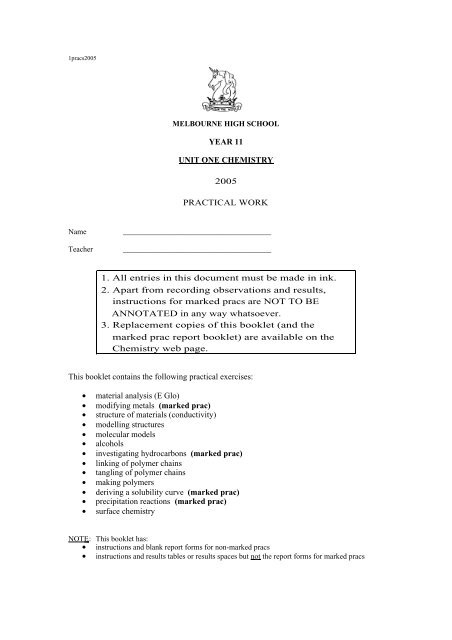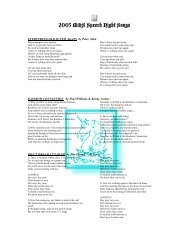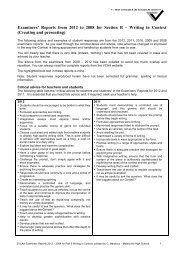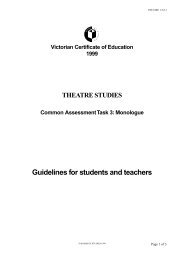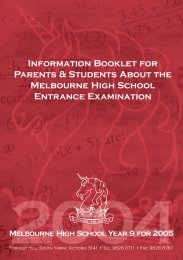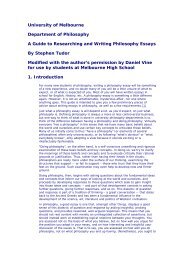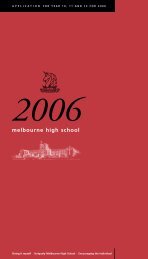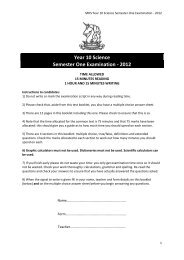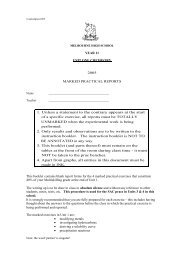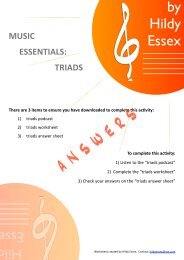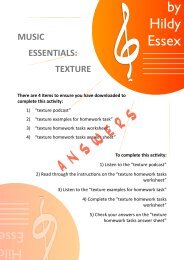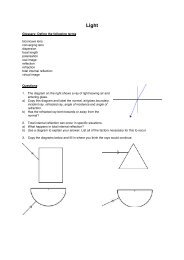YEAR 11 UNIT ONE CHEMISTRY 2005 PRACTICAL WORK 1. All ...
YEAR 11 UNIT ONE CHEMISTRY 2005 PRACTICAL WORK 1. All ...
YEAR 11 UNIT ONE CHEMISTRY 2005 PRACTICAL WORK 1. All ...
You also want an ePaper? Increase the reach of your titles
YUMPU automatically turns print PDFs into web optimized ePapers that Google loves.
1pracs<strong>2005</strong><br />
MELBOURNE HIGH SCHOOL<br />
<strong>YEAR</strong> <strong>11</strong><br />
<strong>UNIT</strong> <strong>ONE</strong> <strong>CHEMISTRY</strong><br />
<strong>2005</strong><br />
<strong>PRACTICAL</strong> <strong>WORK</strong><br />
Name<br />
Teacher<br />
_______________________________________<br />
_______________________________________<br />
<strong>1.</strong> <strong>All</strong> entries in this document must be made in ink.<br />
2. Apart from recording observations and results,<br />
instructions for marked pracs are NOT TO BE<br />
ANNOTATED in any way whatsoever.<br />
3. Replacement copies of this booklet (and the<br />
marked prac report booklet) are available on the<br />
Chemistry web page.<br />
This booklet contains the following practical exercises:<br />
• material analysis (E Glo)<br />
• modifying metals (marked prac)<br />
• structure of materials (conductivity)<br />
• modelling structures<br />
• molecular models<br />
• alcohols<br />
• investigating hydrocarbons (marked prac)<br />
• linking of polymer chains<br />
• tangling of polymer chains<br />
• making polymers<br />
• deriving a solubility curve (marked prac)<br />
• precipitation reactions (marked prac)<br />
• surface chemistry<br />
NOTE : This booklet has:<br />
• instructions and blank report forms for non-marked pracs<br />
• instructions and results tables or results spaces but not the report forms for marked pracs
2<br />
Before any practical exercise ensure that you:<br />
• have read the exercise thoroughly and completely<br />
• understand the theory behind the exercise<br />
• are aware of the safety instructions relevant to the exercise<br />
• have completed any necessary pre-prac calculations or predictions<br />
(if there are any for that particular exercise)<br />
• realised that, unless you have already had two pre-prac tests in the<br />
semester, any exercise is fair game for an unannounced pre-prac<br />
test
3<br />
<strong>2005</strong> MATERIAL ANALYSIS (E Glo)<br />
E Glo is a newly-developed 'glow in the dark' silicone rubber. It is a polymer consisting of long chains<br />
of covalently bonded alternating silicon and oxygen atoms with hydrocarbon side groups bonded to the<br />
Si atoms. The glow is produced by impregnating the polymer with very small amounts of strontium.<br />
The development of a wide range of products from E Glo is only possible if extensive experimentation<br />
is carried out in order to determine the range of properties of the material. The test kit contains E Glo<br />
in various forms and shapes, including off-cuts that come in their raw state directly from the machine<br />
that produced the polymer. The Glo Doh is a silicone rubber that has not been placed under high<br />
pressure to create shapes. <strong>All</strong> samples contain the same percentage of strontium.<br />
Materials and Apparatus<br />
Investigation<br />
• safety goggles • hammer<br />
• apron • scalpel or knife<br />
• E Glo test kit • box with blackened interior<br />
• cement bench mat • apparatus in the bench cupboard<br />
Working in pairs, you are to:<br />
• develop and trial a range of experiments to determine the properties of E Glo<br />
• suggest a number of uses for this material<br />
You will be using an E Glo test kit consisting of a variety of product samples and other materials that<br />
will assist you in determining the properties of E Glo. The contents of the bench cupboards may be<br />
used.<br />
NOTE: Destructive tests must only be performed on very small samples of the<br />
off-cuts.<br />
Aim<br />
Method<br />
Results<br />
.../over
4<br />
Discussion<br />
Possible uses for E Glo<br />
Conclusion<br />
End of experimental work and report
5<br />
Background<br />
<strong>2005</strong> MODIFYING METALS<br />
The properties of metals may be modified in various ways.<br />
treatment and alloying.<br />
Two commonly used ways are heat<br />
The macroscopic properties of a metal will depend on its microstructure - the arrangement of its atoms<br />
into crystals and the elements involved (ie atomic size).<br />
When a metal is cooled slowly, the atoms have time (and sufficient energy during that time) to<br />
rearrange themselves into larger crystals. When a metal is cooled quickly, it forms small crystals<br />
instead. There are weaknesses where these small crystals adjoin one another and hence quenched<br />
metals tend to be more brittle than those cooled slowly.<br />
<strong>All</strong>oys exist either as atoms of similar size replacing some of the original atoms in the lattice or, if<br />
significantly smaller, occupying the existing spaces in the lattice. Consequently, these alloys have<br />
different properties.<br />
Safety<br />
• goggles and an apron must be worn when handling needles and hot metals<br />
• use metal tongs when handling hot objects<br />
• disposal of used solids into the bins is vital – be especially careful of the needles<br />
• lead is toxic ∴ wash hands more thoroughly than usual after handling lead and solder<br />
Materials and Apparatus<br />
Method<br />
• safety goggles • spatula<br />
• apron • metal tongs<br />
• 4 g lead • matches<br />
• 6 g tin • hammer<br />
• 3 identical needles • bunsen burner, tripod and pipeclay<br />
• 100 mL beaker triangle<br />
• crucible (without lid) • 2 bench mats<br />
• aluminium tray • tap water<br />
Note: the tin and lead may already be weighed out for you and placed in plastic bags.<br />
Heat treatment<br />
<strong>1.</strong> Obtain three identical needles and put one needle aside as a control.<br />
2. Using a non-luminous flame (blue), strongly heat another needle for about 1_ minutes then<br />
place it on the cement bench mat and allow it to cool slowly.<br />
3. Heat the remaining needle for a similar time. Then drop it into a 100 mL beaker of cold tap<br />
water.<br />
4. CARE! GOGGLES MUST BE WORN. When the needles are quite cool, try to bend and<br />
break all three. Record your observations.<br />
<strong>All</strong>oying – solder production<br />
<strong>1.</strong> Observe and record the properties listed in the results table (on the next page).<br />
2. Check that your crucible sits in the pipeclay triangle and does not fall through.<br />
3. Roll the tin and lead together into a ball and place it in the crucible.<br />
4. Heat the crucible briefly using the non-luminous flame until a uniform molten mixture is<br />
obtained. Stir the molten metal with a spatula and remove any oxide coating from the top of<br />
the molten metal. [NB: one end of the spatula will become very hot!]<br />
5. Using metal tongs, carefully pour the molten solder into an aluminium tray that is sitting on a<br />
second bench mat. If necessary, flatten the solder with a hammer. When cool, check the<br />
solder and add its properties to your results table.<br />
6. Arrange a small piece of each metal and solder in an equilateral triangle on the aluminium<br />
tray. Heat the centre of the tray and record the order of melting.<br />
7.<br />
.../over<br />
Results
6<br />
Heat treatment<br />
Needle<br />
Observations<br />
control<br />
slow cooling<br />
rapid cooling<br />
<strong>All</strong>oying<br />
Metal Hardness Appearance Other observations<br />
tin<br />
(Sn)<br />
lead<br />
(Pb)<br />
solder<br />
Order of melting: 1st _______________ 2nd _______________ 3rd _______________<br />
End of experimental work<br />
<strong>2005</strong> STRUCTURE OF MATERIALS (CONDUCTIVITY)
7<br />
Background<br />
Metals and non metals combine in various ways to form 5 kinds of structures:<br />
• metallic elements<br />
• non metallic elements<br />
• compounds of non metallic elements<br />
• compounds of metallic and non metallic elements<br />
• compounds of metallic elements (alloys)<br />
This exercise investigates 4 of these 5 categories of substances.<br />
These categories may be distinguished according to different combinations of their physical properties,<br />
especially their melting temperatures and electrical conductivities. These properties are explained in<br />
terms of the bonding present in the substance.<br />
This exercise investigates the electrical conductivity of selected substances in one or more phases:<br />
• solid<br />
• liquid (referred to as molten if the substance is not a liquid at room temperature)<br />
• aqueous solution (dissolved in water)<br />
• organic solution (dissolved in an organic solvent)<br />
Safety<br />
• sulfur and naphthalene must be heated carefully in a fume cupboard and not in the open<br />
laboratory - both are flammable<br />
• solid iodine is corrosive and stains; iodine solution stains and the vapours are toxic - do<br />
not inhale<br />
• cracked test tubes - if any - must be disposed of as directed<br />
• power packs must be switched off before moving to the next location<br />
Materials and Apparatus<br />
Method and results<br />
• power packs • copper foil<br />
• alligator clips • tin foil<br />
• leads • ethanol<br />
• ammeters and/or milliammeters • sucrose (solid and aqueous solution)<br />
• 100 mL beakers • iodine (solid and organic solution)<br />
• large paper clips (for use as electrodes) • sulfur (solid and molten)<br />
• meker burner • naphthalene (solid and molten)<br />
• bunsen burner, bench mats, matches • potassium iodide (solid, molten and<br />
• wire coat hanger electrodes aqueous solution)<br />
• display galvanometer or ammeter • copper(II) sulfate (solid and aqueous<br />
• separators solution)<br />
Note:<br />
If you get all substances to conduct electricity in all the phases tested, then something is<br />
seriously wrong with the exercise!<br />
The various materials are set up at stations around the room - sulfur and naphthalene are in the rear<br />
fume cupboard and molten potassium iodide will be done as a teacher demonstration.<br />
Move around the room to each station. At each station, switch the power pack on, record the current<br />
flow, switch off the power pack and move to another station. Remember to check whether an ammeter<br />
or a milliammeter is in use a particular station and record the appropriate unit for the current.<br />
.../over
8<br />
When at the fume cupboard, test the conductivity of the solids and leave the power pack on when<br />
heating the solids. The substances may shrink when heated so ensure that the electrodes remain in the<br />
liquid. As soon as you've checked the conductivity of the molten materials, turn the bunsen burner off.<br />
Substance and<br />
Ability to conduct electricity when<br />
formula solid liquid/molten dissolved in<br />
solution<br />
copper (Cu)<br />
copper(II) sulfate (CuSO 4 )<br />
ethanol (CH 3 CH 2 OH)<br />
iodine (I 2 )<br />
naphthalene (C 10 H 8 )<br />
potassium iodide (KI)<br />
sucrose (C 12 H 22 O <strong>11</strong> )<br />
sulfur (S)<br />
tin (Sn)<br />
metallic elements<br />
melting temp.<br />
electrical conductivity<br />
(high or low) solid liquid/molten solution<br />
non metallic elements<br />
compounds of<br />
non metals<br />
compounds of metals<br />
and non metals<br />
Questions<br />
<strong>1.</strong> Which substance had mobile charges in the liquid and solution phases but not in the solid state<br />
Explain this in terms of the structure of the substance.<br />
2. What type of melting point did those substances that did not conduct in any state tested exhibit<br />
Why is this the case<br />
3. In which category/ies of substances are there particles that are held together only weakly<br />
End of experimental work and report<br />
<strong>2005</strong> MODELLING STRUCTURES
9<br />
Atomic structure<br />
Brief description and/or diagram of the model:<br />
What are the limitations of this model<br />
Metal structure<br />
Brief description and/or diagram of the model:<br />
What properties of metals may be explained by this model<br />
What are its limitations (ie what properties can't it explain)<br />
NaCl structure<br />
Brief description and/or diagram of the model:<br />
What type of bonding is represented<br />
__________________________________<br />
What properties of NaCl may be explained by this model<br />
What are its limitations<br />
CO 2 structures (2 models)<br />
.../over
10<br />
Brief description and/or diagram of the models:<br />
What type(s) of bonding is/are represented _____________________________________________<br />
What properties of CO 2 may be explained by these models<br />
What are their limitations<br />
Diamond structure<br />
Brief description and/or diagram of the model:<br />
What type of bonding is represented ______________________________________<br />
What properties of diamond may be explained by this model<br />
What are its limitations<br />
Graphite structure<br />
Brief description and/or diagram of the model:<br />
What type(s) of bonding is/are represented _____________________________________________<br />
What properties of graphite may be explained by this model<br />
What are its limitations<br />
End of exercise<br />
<strong>2005</strong> MOLECULAR MODELS
<strong>11</strong><br />
Standard colour coding for molecular models:<br />
• hydrogen - white • carbon - black • oxygen - red<br />
• sulfur - yellow • nitrogen - blue • halogens - green<br />
Number of prongs on clusters:<br />
• 1 - linear (one covalent bond only) • 2 - linear (may represent a triple bond)<br />
• 3 - triangular planar (may represent a<br />
double bond)<br />
• 4 - tetrahedral<br />
Length of straws:<br />
• long - lone pair or single bond representing 1 pair of electrons<br />
• medium - double bond representing 2 pairs of electrons<br />
• short - triple bond representing 3 pairs of electrons<br />
Hints for determining molecular shape:<br />
<strong>1.</strong> Decide which is the central atom; write out its configuration.<br />
2. Write out the configuration of the other elements; determine the number of electrons these<br />
atoms need to share in order to obtain a stable configuration.<br />
3. Determine how many electrons the central atom contributes.<br />
4. Decide whether bonds are single, double or triple and whether there are lone pair(s).<br />
5. When deciding the shape, remember that the electron pairs will be as far away from each other<br />
in 3-dimensional space as possible and that only the relative positions of the nuclei are used to<br />
define the shape.<br />
6. Use the shape chart to determine the molecular shape. [Note that lone pairs are omitted from<br />
the diagrams.]<br />
Method<br />
<strong>1.</strong> Check that the jar containing the model components is complete according to the list on the<br />
jar.<br />
2. Construct each model and draw the structural formula in the space provided in the table on the<br />
next page - use chemical symbols rather than circles to represent nuclei and inner shell non<br />
bonding electrons. [Lone pairs must be included where they affect the shape of the species.]<br />
3. Where possible, determine the shape of the molecule and write it in the structural formula box.<br />
4. Dismantle all components and check that the contents of the jar are still correct.<br />
…/over<br />
Results
12<br />
H 2 O<br />
CH 4<br />
NF 3<br />
shape:<br />
N 2<br />
shape:<br />
CO 2<br />
shape:<br />
HCl<br />
shape:<br />
BF 3<br />
shape:<br />
H 2<br />
shape:<br />
O 2<br />
shape:<br />
C 2 H 6<br />
shape:<br />
C 2 H 4<br />
shape:<br />
CHCl 3<br />
Question<br />
shape: not possible<br />
shape:<br />
shape:<br />
Why is it not possible to describe the shape of the ethane molecule<br />
End of exercise and report<br />
<strong>2005</strong> ALCOHOLS
13<br />
Alcohols are characterised by the presence of the hydroxy group, ⎯OH. The parent alcohol is<br />
methanol, CH 3 OH, and the most common one (and least toxic one, too) is ethanol, CH 3 CH 2 OH.<br />
As the length of the carbon chain increases, the solubility of the alcohol in water decreases.<br />
Models<br />
<strong>1.</strong> Check that the jar containing the model components is complete according to the list on the<br />
jar.<br />
2. Construct models of methanol and ethanol and draw their structural formulae in the space<br />
provided in the table. [Lone pairs must be included where they affect the shape of the<br />
species.]<br />
3. There are two structural isomers of propanol, ie propan-1-ol and propan-2-ol. Both have the<br />
molecular formula C 3 H 8 O. Construct models of the isomers of propanol and draw their<br />
structural formulae.<br />
4. Dismantle all components and check that the contents of the jar are still correct.<br />
propan-1-ol<br />
propan-2-ol<br />
semistructural<br />
formula:<br />
semistructural<br />
formula:<br />
Experimental<br />
Safety<br />
• an apron must be worn<br />
• alcohols are both toxic and flammable<br />
• sulfuric acid is corrosive<br />
• potassium dichromate is an oxidising agent<br />
• food colouring will stain clothes, paper, skin, the bench, reputations, etc.<br />
Materials and Apparatus<br />
Method<br />
• apron • food colouring<br />
• ordinary test tubes and rack • methanol<br />
• micro test tubes, rack and brush • ethanol<br />
• 100 mL beaker • 0.1 M K 2 Cr 2 O 7 solution<br />
• hot water • dilute sulfuric acid<br />
<strong>1.</strong> Solubility in water<br />
* Place a few drops of methanol and ethanol into separate micro test tubes. Add 2 drops of<br />
food colouring to each. Shake.<br />
* Are methanol and ethanol soluble in water Yes / No (strike out the incorrect answer)<br />
* Empty the micro test tubes and clean with the small brush.<br />
2. Reaction with acidified potassium dichromate solution - this reaction is the breathalyser<br />
reaction for the detection of drunk drivers.<br />
.../over
14<br />
* place potassium dichromate solution in an ordinary sized test tube to a depth of about 2 cm.<br />
Carefully add about 1 cm in depth of dilute sulfuric acid. Next add a few drops of ethanol.<br />
Shake the test tube carefully then place it in a 100 mL beaker of warm to hot water.<br />
* record colour changes over about 5 minutes.<br />
* using one hand, waft some vapour from the test tube to your nose. Do not snort! Record<br />
odour changes over time.<br />
* rinse the test tube and put all equipment away.<br />
Colour changes: ____________________________________________________________________<br />
Odour changes:<br />
____________________________________________________________________<br />
Questions<br />
<strong>1.</strong> Can you write an equation that explains the reaction between ethanol and acidified potassium<br />
dichromate solution Yes / No (There is no penalty for being honest, only for lying.)<br />
My attempt is: (Your teacher may assist you.)<br />
________________________________________________________________________________<br />
Working space for your equation:<br />
2. Why does the solubility of alcohols in water decrease as the length of the hydrocarbon chain<br />
increases<br />
3. Why is ethanol soluble in water whereas ethane is not<br />
End of experimental work and report<br />
Background<br />
<strong>2005</strong> INVESTIGATING HYDROCARBONS
15<br />
Hydrocarbons are organic compounds composed only of carbon and hydrogen. They are non-polar<br />
molecules are therefore are soluble in non-polar solvents. Hydrocarbons have no functional groups.<br />
When they undergo complete combustion, they form only carbon dioxide and water. However, if the<br />
combustion is incomplete, they form carbon (or carbon monoxide) and water. The main component of<br />
natural gas is methane, CH 4 .<br />
A saturated hydrocarbon has only single covalent bonds between the carbon atoms. If a hydrocarbon<br />
is unsaturated, then it has a double or triple bond between at least two of the carbon atoms. If bromine<br />
solution reacts rapidly with a hydrocarbon, then the hydrocarbon must be unsaturated. The distinctive<br />
colour of the bromine disappears as the double (or triple) bond in the hydrocarbon is converted to a<br />
single bond and a bromine atom is added to each of the carbon atoms that were originally involved in<br />
the double bond.<br />
Safety<br />
• bunsen burners must be used first and put away before any liquid or solid<br />
hydrocarbons are used by any student<br />
• hydrocarbon residues must be poured into the organic residue bottle in the fume<br />
cupboard and NOT poured down the sink<br />
• bromine solution is corrosive and readily absorbed through the skin<br />
• organic bromine compounds may cause impotence (and we don’t want any embarrassment)<br />
• goggles and aprons must be worn<br />
• exhaust fans should be switched on (NOT the normal ceiling fans - why not)<br />
Materials and Apparatus<br />
Method and Results<br />
• small bunsen burner • cement bench mat<br />
• cyclohexane • test tubes and rack (for bunsen test)<br />
• cyclohexene • micro test tubes and rack (for<br />
• naphthalene hydrocarbons tests)<br />
• dropping bottle of food colouring • wooden test tube holder<br />
• bromine dissolved in hexane or • matches<br />
heptane • goggles<br />
• small spatula • apron<br />
• organic residue bottle<br />
A. Combustion of hydrocarbons<br />
Light a small bunsen burner with the air hole closed so that a luminous (yellow safety) flame is<br />
obtained. Using a wooden test tube holder in the prescribed manner (ie with the holder close to the<br />
open end and the test tube inclined at an angle of about 45 o ), hold the test tube in the flame for about<br />
30 s. Record your observations. Open the air hole and heat the test tube for a couple of minutes in<br />
the non-luminous (blue) flame. Record your observations.<br />
ALL students must return the bunsen burner, etc., to the correct place in<br />
the cupboard BEFORE ANY<strong>ONE</strong> starts parts B and C.<br />
Air hole<br />
Observations<br />
closed<br />
open<br />
.../over<br />
B. Solubility of hydrocarbons in water
16<br />
Mix 10 drops of drops of each liquid hydrocarbon or a tiny piece of a solid hydrocarbon separately<br />
with 10 drops of coloured water in micro test tubes.<br />
Hydrocarbon<br />
Observations<br />
cyclohexane<br />
C 6 H 12 (l)<br />
cyclohexene<br />
C 6 H 10 (l)<br />
naphthalene<br />
C 10 H 8 (s)<br />
C. Saturation and unsaturation in hydrocarbons<br />
Place 10 drops of drops of each liquid hydrocarbon or a tiny piece of a solid hydrocarbon separately in<br />
micro test tubes. Add a few drops of bromine solution to each test tube.<br />
Return all cleaned apparatus, chemicals, etc., to the correct place and clean the bench.<br />
Hydrocarbon<br />
Observations<br />
cyclohexane<br />
C 6 H 12 (l)<br />
cyclohexene<br />
C 6 H 10 (l)<br />
naphthalene<br />
C 10 H 8 (s)<br />
End of experimental work<br />
Background<br />
<strong>2005</strong> LINKING POLYMER CHAINS (SLIME)
17<br />
Polyvinyl alcohol is an addition polymer formed from vinyl alcohol (its systematic name is ethenol).<br />
The polymer dissolves in water because the ⎯OH groups form hydrogen bonds with the water<br />
molecules.<br />
The addition of borax solution to a polyvinyl alcohol solution creates cross-links between the alcohol<br />
chains and the tetraborate ions, B(OH) 4 - , present in the borax solution.<br />
The result is a gel (pronounced "jell") in which the water molecules are trapped between the polymer<br />
chains - about 95% of the gel is water.<br />
Unlike the cross-links formed by covalent bonds, the links in the gel break and reform easily giving the<br />
material some interesting physical properties. The gel behaves as a non-Newtonian liquid - it flows<br />
when pulled gently apart and snaps if pulled sharply. If the slime is poured from its container and the<br />
container tipped upwards slightly, the gel self-siphons. A lump of slime placed in a container slowly<br />
flows to fit the container and one placed on the bench slowly spreads out.<br />
The food colouring is used simply to improve the appearance of the slime.<br />
H H H H H H H H H H<br />
⏐ ⏐ ⏐ ⏐ ⏐ ⏐ ⏐ ⏐ ⏐ ⏐<br />
Polyvinyl alcohol is ⎯ C ⎯ C ⎯ C ⎯ C ⎯ C ⎯ C ⎯ C ⎯ C ⎯ C ⎯ C ⎯<br />
⏐ ⏐ ⏐ ⏐ ⏐ ⏐ ⏐ ⏐ ⏐ ⏐<br />
H OH H OH H OH H OH H OH<br />
Safety<br />
• borax is toxic - it is used as an ant killer<br />
• food colouring stains clothes, paper, skin, the bench, etc., as it is a dye<br />
• hands must be washed more thoroughly than usual at the end of the exercise<br />
• aprons must be worn<br />
Materials and Apparatus<br />
• apron • 100mL measuring cylinder<br />
• 100 mL beaker • 4% borax solution<br />
• glass stirring rod • 6% polyvinyl alcohol solution<br />
• 10mL measuring cylinder • red or green food colouring<br />
NOTE: The polyvinyl alcohol solution may be labelled Solution A, the borax solution may<br />
be labelled Solution B and the food colouring may be labelled Solution C.<br />
Method<br />
.../over<br />
*** In this exercise, the proportions of the solutions used must be adhered to or your slime will be
18<br />
less than perfect (and rather messy, too)<br />
<strong>1.</strong> Use the 100 mL measuring cylinder to add 20 mL of polyvinyl alcohol solution to a 100 mL<br />
beaker. Add 3 drops of food colouring.<br />
2. Use the 10 mL measuring cylinder to add 4 mL of borax solution to the beaker. Stir the<br />
mixture thoroughly to produce your slime.<br />
3. Remove the slime from the beaker and explore its properties - the slime will be less sticky if<br />
your hands are clean and dry.<br />
4. Clean the beaker, both measuring cylinders and stirring rod, invert the beaker in your<br />
cupboard, return solutions to the designated place, wipe down the bench and wash your hands<br />
more thoroughly than usual.<br />
Observations and questions<br />
<strong>1.</strong> Compare the properties of polyvinyl alcohol solution and slime:<br />
Properties of polyvinyl alcohol solution<br />
Properties of slime<br />
2. Why is polyvinyl alcohol soluble in water<br />
3. Compare the physical properties of polymers that are cross-linked by frequent covalent bonds<br />
with those of slime.<br />
4. What common polymers contain hydrogen bonds between their chains<br />
End of experimental work and report<br />
<strong>2005</strong> TANGLING OF POLYMER CHAINS<br />
The amount of tangling that occurs between polymer chains depends on the size of the polymer.
19<br />
Materials and Apparatus<br />
Method<br />
• reel of cotton • metre rule<br />
• 2 × 250 mL conical flasks with • tweezers<br />
stoppers • 100 mL measuring cylinder<br />
• scissors • tap water<br />
• glass stirring rod<br />
<strong>1.</strong> Cut 24 pieces of cotton 10 cm in length and 6 pieces 40 cm in length.<br />
2. Place the short lengths of cotton in one conical flask and the long pieces in the other conical<br />
flask. Add 100 mL of tap water to each flask, stopper the flasks and shake each one for 90 s.<br />
3. Use the glass rod to remove the cotton from each conical flask and gentle squeeze out the<br />
excess water from each bundle. Using the tweezers only, separate the treads of cotton in each<br />
of the bundles.<br />
4. Place used cotton in the bin, return the apparatus to the correct place and wipe down the<br />
bench.<br />
Questions<br />
<strong>1.</strong> What effect does the length of the treads have on the ease of removal of the cotton pieces<br />
from the bundle<br />
2. What difference would you expect between the tangling of large and small polymers<br />
End of experimental work and report<br />
A. Urea-formaldehyde plastic<br />
<strong>2005</strong> MAKING POLYMERS
20<br />
NOTE: Due to health concerns with the use of methanal (formaldehyde), this part of the exercise will<br />
be done as a teacher demonstration. However, students are required to answer the questions.<br />
If a polymer does not melt on heating but only chars, then it is a crosslinked (covalent bonding and no<br />
discrete chains) thermosetting polymer. If it softens when heated and hardens again on cooling, then it<br />
is a thermosoftening (thermoplastic) polymer with only weak interchain bonding (dispersion forces,<br />
hydrogen bonding, tangling).<br />
Safety<br />
• methanal (formaldehyde) is a suspected carcinogen<br />
• large amounts of heat and very unpleasant fumes are released when the reaction occurs<br />
• concentrated sulfuric acid is an excellent dehydrating agent - it will dehydrate and<br />
severely burn you if it comes into contact with your skin, clothes, etc. The bench will<br />
also be damaged. If any is spilt, flood it immediately with vast amounts of water,<br />
advise your teacher and then clean up the mess.<br />
• aprons and goggles must be worn<br />
Materials and Apparatus - teacher demo only<br />
Method and Results<br />
• goggles • electronic balance<br />
• apron • 10 mL measuring cylinder<br />
• heat resistant container • metal tongs<br />
• stirring rod • urea<br />
• spatula • formaldehyde solution (methanal)<br />
• watch glass • dropping bottle of concentrated<br />
• bench mat sulfuric acid<br />
<strong>1.</strong> Pour 6 mL of methanal (formaldehyde) solution into a suitable heat resistant container. Add<br />
3 g of urea and stir until a saturated solution is obtained.<br />
2. Carefully add a few drops of concentrated sulfuric acid and stir the mixture. The mixture<br />
should harden quite suddenly.<br />
3. Thoroughly wash and dry the solid.<br />
4. Use tongs to hold a small piece of the dried solid in a bunsen flame.<br />
a/ i. What colour is the polymer ________________________________<br />
ii. Is the polymer hard or soft<br />
iii. What type of polymer is urea-formaldehyde<br />
________________________________<br />
________________________________<br />
iv. Does this polymer contain linear or crosslinked chains How do you know<br />
b/ Draw the structural formula of:<br />
i. urea CO(NH 2 ) 2 ii. methanal (formaldehyde) HCHO<br />
c/ Methanal reacts with water to form methandiol, CH 2 (OH) 2 , which is the species that reacts directly<br />
with the urea molecules.<br />
i. Draw the structural formula of methandiol.<br />
.../over
21<br />
ii. What structural feature (relevant to polymerisation) is exhibited by both urea and<br />
methandiol molecules<br />
B. Making nylon: preparation of a synthetic fibre<br />
A fibre is composed of polymer molecules aligned so that effective forces of attraction exist along<br />
significant portions of its length. A fibre is at least 100 times long as it is wide.<br />
One of the first fully synthetic fibres was nylon. There are several varieties of nylon, each having<br />
slightly different monomers and, therefore, slightly different properties. Normally, nylon is made by<br />
reacting 1,6-diaminohexane (hexamethylene diamine) with a diacid such as sebacic acid. However, to<br />
increase the reaction rate, we will use decan-1,10-dioyl chloride (sebacoyl chloride), which is similar in<br />
structure, in place of sebacic acid.<br />
Hexamethylene diamine is H 2 N.(CH 2 ) 6 .NH 2 and sebacoyl chloride is ClOC.(CH 2 ) 8 .COCl.<br />
Nylon is a condensation polymer. As suggested by the numbers, nylon 6,10 is made from a six-carbon<br />
and a ten-carbon monomer. When these combine, HCl is the small molecule eliminated.<br />
Safety<br />
• gloves, aprons and goggles must be worn<br />
• both monomers (hexamethylene diamine and sebacoyl chloride) are skin irritants<br />
• used solutions must be placed in the organic residue bottle<br />
• hand must be washed more thoroughly than usual at the end of the exercise<br />
Materials and Apparatus<br />
• goggles • organic residue bottle<br />
• apron • sebacoyl chloride solution (dissolved<br />
• gloves in an organic solvent)<br />
• 100 mL beaker • hexamethylene diamine solution<br />
• 2 × 10 mL measuring cylinders (dissolved in water)<br />
• glass stirring rod • tray for drying nylon<br />
• tweezers<br />
Method<br />
.../over<br />
<strong>1.</strong> Using a 10 mL measuring cylinder, transfer 10 mL of hexamethylene diamine solution into a<br />
100 mL beaker. Using a different 10 mL measuring cylinder, measure out 10 mL of sebacoyl<br />
chloride solution.
22<br />
2. Hold the beaker at an angle of about 45 o . Slowly and carefully pour the sebacoyl chloride<br />
solution down the side of the beaker so that it forms a layer on top of the hexamethylene<br />
diamine solution . The solutions do not mix but a small amount of solid will form at the<br />
interface.<br />
3. Using a pair of tweezers, pull out a little of this solid and wind this nylon fibre along the<br />
length of a glass rod - do not let the any of the fibre overlap. Wind as much nylon from the<br />
interface as possible. Carefully rinse the nylon with tap water, remove it from the rod and<br />
place it on the tray, as directed, to dry.<br />
4. Stir the used solution and a lump of nylon may form. Rinse it and add it to your fibre on the<br />
tray.<br />
5. The used solution must be poured into the organic residue bottle in the fume cupboard and<br />
not down the sink.<br />
6. Clear away the equipment. rinsing the measuring cylinders very thoroughly. Wash your<br />
hands more thoroughly than usual before leaving.<br />
7. When dry, heat a small amount of your nylon in a bunsen flame.<br />
Questions<br />
<strong>1.</strong> Both monomer molecules are polar and have large non-polar regions, so why is the sebacoyl<br />
chloride solution made up in an organic solvent whereas the hexamethylene diamine solutions<br />
uses water as the solvent<br />
2. Use the formulae of the nylon 6, 10 monomers to draw a section of the nylon polymer<br />
showing three (3) amide linkages.<br />
3. What happened when the nylon was heated<br />
4. What is the major type of bonding found between nylons chains Why is this the case<br />
End of experimental work and report<br />
<strong>2005</strong> DERIVING A SOLUBILITY CURVE<br />
The solubility of a solute tells us the maximum amount of solute that can dissolve in a given amount of<br />
solvent at a given temperature.
23<br />
In this exercise, you will be determining the solubility of potassium nitrate (in g of potassium nitrate<br />
per 100 g of water) at various temperatures and graph the results.<br />
You will need to assume that the density of water 1 g mL -1 at all temperatures. Although the density<br />
of water does vary with temperature, it is a reasonable approximation to make in view of the other<br />
errors associated with this determination. Therefore, when 5.00 mL of water is added to the solute, it<br />
can be said to be equivalent to the addition of 5.00 g of water, and so on.<br />
Safety<br />
• aprons must be worn<br />
• the test tube must be heated in a water bath and not directly in a bunsen flame<br />
• self-emptying test tubes indicate carelessness - wipe up any spillage immediately and<br />
put the damaged test tube in the glass bin<br />
Materials and Apparatus<br />
Method<br />
• apron • bunsen burner, tripod, gauze<br />
• large test tube • spatula<br />
• burette, stand and small funnel • KNO 3 crystals<br />
• 500 mL beaker • ice<br />
• -10 - <strong>11</strong>0 o C thermometer • deionised water<br />
• electronic balance • tap water<br />
• bench mat • matches<br />
• large jar for collecting the used KNO 3 solution<br />
<strong>1.</strong> Weigh accurately approximately 6.5 g of solid potassium nitrate into a large test tube.<br />
Record the mass to 3 decimal places.<br />
2. Use a burette to deliver exactly 5.00 mL of deionised water into the test tube.<br />
3. Immerse the test tube in a large beaker containing about 250 mL of boiling tap water and<br />
gently stir the contents using the thermometer until all the crystals have dissolved.<br />
4. Remove the test tube from the boiling water and continue to stir gently until the first signs of<br />
crystallisation are detected. Record the temperature at which the crystals start to form.<br />
5. Add a further 3.00 mL of deionised water from the burette into the test tube and repeat Steps 3<br />
and 4.<br />
6. Repeat Step 5 as many times as necessary until the stage is reached that crystallisation won't<br />
occur even when ice is used to cool the solution.<br />
7. Pour your KNO 3 solution into the large collection jar provided.<br />
8. Leave the burette set up on the bench, clean away all other equipment and wipe down the<br />
bench.<br />
Results and Calculations<br />
*** the results table is on the next page<br />
• the solubility of, say, 6.500 g of potassium nitrate dissolved in 5.00 g of water is equivalent to<br />
as solubility of (6.500 × 100) ÷ 5.00 = 130 g per 100g<br />
• complete your results table on the report form<br />
• draw your graph with the independent variable (temperature) on the horizontal axis<br />
Mass of KNO 3<br />
(g)<br />
(constant)<br />
Total volume of water<br />
(mL)<br />
Temperature at which<br />
crystals first form<br />
( o C)<br />
.../over
24<br />
End of experimental work<br />
<strong>2005</strong> PRECIPITATION REACTIONS<br />
When two solutions of ions are mixed, the resulting solution may instantaneously become<br />
supersaturated with a newly formed compound. If this occurs, a precipitate will form. For example, if<br />
a solution of Ba 2+ 2-<br />
ions (eg BaCl 2 ) is added to a solution of SO 4 ions (eg Na 2 SO 4 ), the resulting
25<br />
mixture will be supersaturated with respect to BaSO 4 . A precipitate of BaSO 4 will form until the<br />
solution is saturated. The ionic equation for the reaction is:<br />
Ba 2+ (aq) + SO 2- 4 (aq) → BaSO 4 (s)<br />
Safety<br />
• aprons must be worn<br />
• compounds of lead and barium are toxic<br />
• silver nitrate solution stains, clothes, paper, skin, the bench, etc., but it does so slowly<br />
and not obviously<br />
• silver nitrate crystals can burn the skin<br />
• any spillages - especially silver nitrate solution - must be cleaned up immediately<br />
Materials and Apparatus<br />
Method<br />
• apron • 0.1 M potassium iodide<br />
• micro test tubes and rack • 0.1 M silver nitrate<br />
• micro test tube brush • 0.1 M potassium chromate<br />
dropping bottles containing: • 0.1 M copper(II) sulfate<br />
• 0.1 M sodium carbonate • 0.1 M barium chloride<br />
• 0.1 M lead(II) nitrate<br />
Precipitate predictions must be made in INK prior to<br />
the exercise being done in class. No alteration to<br />
your predictions will be permitted.<br />
<strong>1.</strong> Before the prac class, predict the precipitate, if any, that will form when the following<br />
solutions are mixed and record your predictions in the table on the next page:<br />
• lead(II) nitrate and sodium carbonate<br />
• lead(II) nitrate and potassium iodide<br />
• sodium carbonate and potassium iodide<br />
• silver nitrate and potassium iodide<br />
• silver nitrate and potassium chromate<br />
• lead(II) nitrate and silver chromate<br />
• copper(II) sulfate and sodium carbonate<br />
• copper(II) sulfate and barium chloride<br />
• lead(II) nitrate and barium chloride<br />
• barium chloride and potassium chromate<br />
• barium chloride and silver nitrate<br />
• copper(II) sulfate and lead (II) nitrate<br />
2. Mix the pairs of compounds by adding a few drops of each to separate clean micro test tubes.<br />
Record your observations.<br />
3. Use the micro test tube brush to thoroughly clean the micro test tubes and, when clean, place<br />
them upside down in the micro test tube rack to drain.<br />
4. Return the dropping bottles to the correct container on the side bench.<br />
*** the predictions and results table is on the next page<br />
.../over<br />
Results<br />
Reagents Predicted ppt. Observations
26<br />
Pb(NO 3 ) 2<br />
and<br />
Na 2 CO 3<br />
Pb(NO 3 ) 2<br />
and<br />
KI<br />
Na 2 CO 3<br />
and<br />
KI<br />
AgNO 3<br />
and<br />
KI<br />
AgNO 3<br />
and<br />
K 2 CrO 4<br />
Pb(NO 3 ) 2<br />
and<br />
K 2 CrO 4<br />
CuSO 4<br />
and<br />
Na 2 CO 3<br />
CuSO 4<br />
and<br />
BaCl 2<br />
Pb(NO 3 ) 2<br />
and<br />
BaCl 2<br />
BaCl 2<br />
and<br />
K 2 CrO 4<br />
BaCl 2<br />
and<br />
AgNO 3<br />
CuSO 4<br />
and<br />
Pb(NO 3 ) 2<br />
Note :<br />
If a precipitate is formed in the third test, then either you have the wrong solution(s) or your<br />
test tube has not been thoroughly cleaned.<br />
End of experimental work<br />
<strong>2005</strong> SURFACE <strong>CHEMISTRY</strong><br />
Safety<br />
• an apron must be worn
27<br />
• as this exercise is rather messy, a clean and safe working environment is even more<br />
important than usual<br />
• capillary tubes are fragile<br />
• the dye mixture will stain skin, clothes, the bench, paper, etc.<br />
• use the organic residue bottle as directed<br />
Materials and Apparatus<br />
• apron • butter, milk, shaving cream<br />
• deionised water • paraffin oil<br />
• detergent solution • stoppers for test tubes<br />
• cooking oil • tweezers<br />
• microscope slides • capillary tubes<br />
• pieces of ceramic • metal washers<br />
• wax • disposable plastic petri dishes<br />
• lycopodium or sulfur powder • droppers<br />
• powdered dye mixture containing • small spatula<br />
methylene blue and Sudan IV • organic residue bottle<br />
Method<br />
A. Wetting<br />
Place one drop of the liquids listed in the results table on the surface specified. Draw the appearance<br />
of the liquid drop when it is on the surface.<br />
deionised water<br />
glass ceramic wax<br />
detergent solution<br />
cooking oil<br />
B. Surfactants<br />
<strong>1.</strong> Fill a beaker with water. Sprinkle lycopodium powder or powdered sulfur on the surface of the<br />
water. Add 1 drop of detergent to the centre of the water.<br />
2. Fill a petri dish to overflowing with water. Use a ruler to quickly scrape off the liquid from the top<br />
of the petri dish (and wipe up any mess!) . Record the number of metal washers that can be added<br />
using tweezers before the water overflows. Repeat but add 6 drops of detergent to the water before<br />
adding the washers.<br />
3. Carefully position a capillary tube so that one end is just below the surface of water and measure the<br />
height of the water in the capillary. Do the same using concentrated detergent solution.<br />
*** The results table is on the next page.<br />
Test Observations Explanation<br />
.../over<br />
lycopodium or<br />
sulfur powder
28<br />
washers<br />
number in water =<br />
number in detergent =<br />
capillary tubes<br />
height in water =<br />
height in detergent =<br />
C. Emulsions<br />
• The dye mixture contains a water-soluble blue dye and an oil-soluble red dye. [Of necessity,<br />
the dye mixture will stain everything! You have been warned - twice.]<br />
<strong>1.</strong> Measure 3 mL of water and 3mL of paraffin oil into the same test tube. Stopper and shake<br />
vigorously. <strong>All</strong>ow to stand for a brief period and record observations. Add 3 drops of detergent and a<br />
tiny amount of the dye mixture, stopper, shake, allow to stand and record observations.<br />
2. Using a glass stirring rod, mix a tiny amount of the dye mixture with a small amount of each of the<br />
emulsions listed into the one petri dish and hence determine the type of emulsion.<br />
3. Dispose of the used petri dish into the rubbish bin<br />
Test Observations Explanation<br />
water and paraffin oil<br />
water, paraffin oil and<br />
detergent<br />
emulsions:<br />
type of emulsion:<br />
butter<br />
milk<br />
shaving cream<br />
End of experimental work and report


